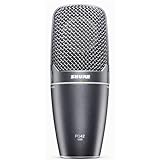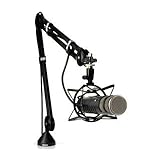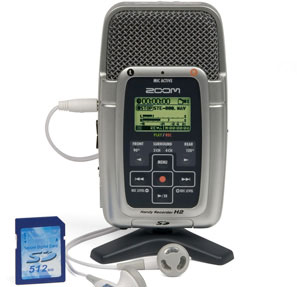I got a lot of emails asking just how the CAGcast is produced so I've decided to put together this post, which is a work in progress. Updated 4/2021
Since all of us are in different locations, we talk to each other over Skype Zoom.
We both record our own voices locally, direct from our microphones (rather than through Skype) using the following hardware and software:
Hardware
Spring 2021 UPDATE: Cheapy and Ship now use a Shure SM7B and GOXLR interface. This is expensive equipment and is absolutely not necessary for a quality production.
UPDATE: Every one switched to a Shure PG42 USB on a RODE PSA 1 Mic Arm in November/December 2012. A year or two later, Cheapy switched to a Rode NT-USB. This setup is appropriate for a 1 person per location podcast.


Old info
[hiddenlist]
CheapyD (and Shipwreck)
I use the Samson CO3U USB microphone. I purchased the podcast pack because it comes with a shock-mount and stand. It also comes with a hard travel case, but the thing is so ing big, I don't think I will ever use it. Cakewalk Sonar LE is included too, but I haven't bothered to figure out how to use it. I've also added a pop-filter as the mic is pretty sensitive. The nice thing about using a high-quality USB mic is that it doesn't require the use of an external mixing board. I liked this setup so much, I got one for the Shipwrecks. I record and edit on a 2.4Ghz Core 2 Duo iMac with 3GB RAM. One of the great things about the iMac is that it runs almost completely silent. Many PCs have noisy fans (like Wombat's) and this can be pretty annoying when it gets picked up by the mic.
ing big, I don't think I will ever use it. Cakewalk Sonar LE is included too, but I haven't bothered to figure out how to use it. I've also added a pop-filter as the mic is pretty sensitive. The nice thing about using a high-quality USB mic is that it doesn't require the use of an external mixing board. I liked this setup so much, I got one for the Shipwrecks. I record and edit on a 2.4Ghz Core 2 Duo iMac with 3GB RAM. One of the great things about the iMac is that it runs almost completely silent. Many PCs have noisy fans (like Wombat's) and this can be pretty annoying when it gets picked up by the mic.

Wombat
As of CAGcast #133, Wombat is using a Macbook and a Zoom H2 USB Mic/Flash Recorder.
As of CAGcast #152, Wombat is using a Samson G Track USB Mic.

Old setup
Since all of us are in different locations, we talk to each other over Skype Zoom.
We both record our own voices locally, direct from our microphones (rather than through Skype) using the following hardware and software:
Hardware
Spring 2021 UPDATE: Cheapy and Ship now use a Shure SM7B and GOXLR interface. This is expensive equipment and is absolutely not necessary for a quality production.
UPDATE: Every one switched to a Shure PG42 USB on a RODE PSA 1 Mic Arm in November/December 2012. A year or two later, Cheapy switched to a Rode NT-USB. This setup is appropriate for a 1 person per location podcast.


Old info
[hiddenlist]
CheapyD (and Shipwreck)
I use the Samson CO3U USB microphone. I purchased the podcast pack because it comes with a shock-mount and stand. It also comes with a hard travel case, but the thing is so
 ing big, I don't think I will ever use it. Cakewalk Sonar LE is included too, but I haven't bothered to figure out how to use it. I've also added a pop-filter as the mic is pretty sensitive. The nice thing about using a high-quality USB mic is that it doesn't require the use of an external mixing board. I liked this setup so much, I got one for the Shipwrecks. I record and edit on a 2.4Ghz Core 2 Duo iMac with 3GB RAM. One of the great things about the iMac is that it runs almost completely silent. Many PCs have noisy fans (like Wombat's) and this can be pretty annoying when it gets picked up by the mic.
ing big, I don't think I will ever use it. Cakewalk Sonar LE is included too, but I haven't bothered to figure out how to use it. I've also added a pop-filter as the mic is pretty sensitive. The nice thing about using a high-quality USB mic is that it doesn't require the use of an external mixing board. I liked this setup so much, I got one for the Shipwrecks. I record and edit on a 2.4Ghz Core 2 Duo iMac with 3GB RAM. One of the great things about the iMac is that it runs almost completely silent. Many PCs have noisy fans (like Wombat's) and this can be pretty annoying when it gets picked up by the mic.
Wombat
As of CAGcast #133, Wombat is using a Macbook and a Zoom H2 USB Mic/Flash Recorder.
As of CAGcast #152, Wombat is using a Samson G Track USB Mic.

Old setup
Wombat uses a 12 year old pro studio mic (model unknown) connected to his PC via a Yamaha 10/2 G Mixing Board (model discontinued).
He records on a p.o.s. Windows PC.
Yamaha 10/2 G Mixing Board
 [/hiddenlist]
[/hiddenlist]
Software & Production
I use 3 pieces of software for the CAGcast production
Audacity (PC/Mac - Free) Everyone on the CAGcast records directly from their mics into Audacity and exports the audio as a 128Kbps MP3 file. It's also used to produce (edit) the show.
Levelator (PC/Mac - Free) Automatically levels the audio. Great for podcasts.
Audio Hijack Pro (Mac - $32) This is optional, but I use it to record audio from YouTube and others for the CAGcast intros and outros.
How to produce a decent sounding Podcast
He records on a p.o.s. Windows PC.
Yamaha 10/2 G Mixing Board

Software & Production
I use 3 pieces of software for the CAGcast production
Audacity (PC/Mac - Free) Everyone on the CAGcast records directly from their mics into Audacity and exports the audio as a 128Kbps MP3 file. It's also used to produce (edit) the show.
Levelator (PC/Mac - Free) Automatically levels the audio. Great for podcasts.
Audio Hijack Pro (Mac - $32) This is optional, but I use it to record audio from YouTube and others for the CAGcast intros and outros.
How to produce a decent sounding Podcast
- First, put on a pair of headphones and plug them into your PC/Mac.
- Using Audacity, line up the vocal tracks and make sure they stay in-sync throughout the entire show. It usually only requires one or two small adjustments if everyone is recording on the same (type of) equipment.
- Run the Noise Reduction
- filter to remove background noise from all 3 tracks.
- Adjust the gain on each of the tracks (watch the meter at the top to avoid clipping) so the sound is uniform.
- Export the file to WAV format.
- Import the WAV file into Levelator. Levelator will automatically level the audio, and spit you back another WAV file.
- Import your newly leveled WAV file into Audacity. Now you can add an intro, outro, or any other audio to your show. Make sure you save your work often. Audacity will auto-backup (check your settings), but its always good to be careful.
- When finished, export your file. Select the MP3 format and click the options button to select 80kbps. After you have you file, you can use iTunes or other programs to add data (title, artists, artwork) to your MP3 file.
- The CAGcast is hosted at Libsyn.
Equipment Recomendations
If you are just starting out (with no audience) and money is tight, there is really no reason to invest hundreds of dollars in a podcasting setup. I'd recommend using Audacity (free) for your recording and editing duties and making due with a current mic if you already own one (and its not completely awful). If you are able to build an audience, you can then decide if its worth investing in a better microphone, in which case I definitely recommend the Samson line of USB condensor mics. The prices on these are consistently falling so keep on 'em.
Also, check out the Zoom H2 USB Mic/Flash Recorder. It's about $135 now and functions as a hand held recordable as well as a USB mic. It's a pretty impressive device.
Hosting
The CAGcast and CAG Foreplay podcasts are hosted at Libsyn. Their $12/month plan should be fine for your standard 1 x week audio podcast.
General Podcast Tips
1) Prepare: Write up an outline of the topics you want to cover, and the order you want to cover them in. This is not a script, but a road map of the show. Jot down brief notes so you don't forget key points.
2) Energize: If you don't sound interested, your audience won't be interested either. Keep those energy levels high.
3) Produce: Use the above guide to make your show sound good!
Good luck!
Last edited by a moderator:








